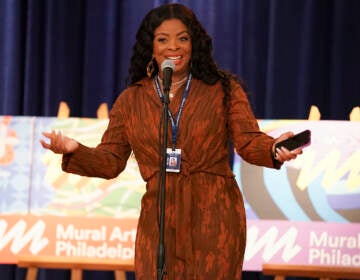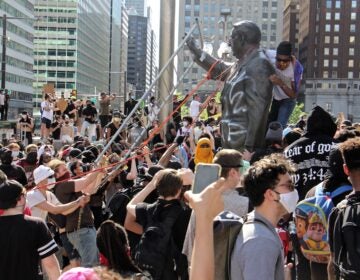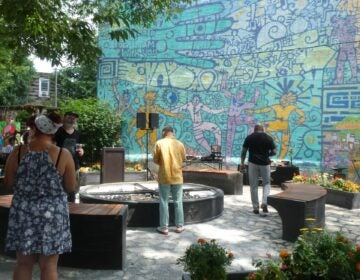The walls that speak: Philadelphia’s top triumphs and trials in street art
Though Philadelphia’s murals are staples of the city, not all of these artistic expressions are embraced with open arms.

Cesar Viveros’ My Life, My Path, My Destiny, sits on a quarter of a mile wall in 'Port Fishington.' The mural is now defaced with graffiti tagging (Brianna Hill/WHYY)
In a city where walls speak with color, Philadelphia’s vibrant murals tell a tale of history and culture that’s unmatched. Guided by the visionary efforts of Mural Arts Philadelphia, these artistic expressions have become a defining feature of the city. And thanks to both the artists and community, Philly earned its title this summer as the best city for street art, according to USA Today.
Mural Arts Philadelphia, formally known as the Philadelphia Anti-Graffiti Network, was established in 1984 as a city-wide effort to combat vandalism and support urban creativity. Led by Jane Golden, it transformed the talents of graffiti artists into a force for beautification and unity.
The organization has been a part of countless initiatives to not only support local artists, but also inmates, individuals struggling with substance abuse, at-risk youth, and even children in foster care.
Since its inception, it has led to Philadelphia becoming the “Mural Capitol of the World”, producing over 4,000 murals, actively engaging local communities, and using art to promote social change. 15,000 residents and tourists visit the outdoor gallery each year.
Today, these murals stand as a symbol of Philadelphia’s thriving cultural identity. But, while narrating the city’s diverse and intricate story, these canvases have presented opportunities for defacement. Mural vandalism, an issue that has historically cost Mural Arts approximately $60,000 annually, saw a surge in their fiscal year of 2023, with a 12% increase in vandalism from the previous year, affecting over 50 mural sites.
According to Golden, many of these cases are simply graffiti tagging and can become more evident for murals that are in more discrete locations, like under bridges or in dark areas. Since COVID, there has been an increase in graffiti tagging around the city, but Golden would like to find a solution to this problem in the near future.
“I feel like this is very familiar territory to me. And I feel that there’s a way to deal with it that isn’t just about investing more and more money just to white out graffiti. I see why the city does it and I commend the clip program. I think they do really good work. But I’d like to do something else,” said Golden.
Golden hopes to expand art education as the organization approaches its 40th anniversary in 2024.
As these dynamic works of art continue to reflect both creativity and controversy, join us as we explore the most celebrated and the most vandalized murals, painting a picture as complex and colorful as the ‘City of Brotherly Love’ itself.
1. A Love Letter for You (mural series)
By Steve Powers | 2010 | Market Street from 46th to 63rd streets
This 50-mural project which was done in 2010, can be glanced upon from the Market-Frankford line. Painted by Steve Powers, a West Philadelphia native, this fascinating and continuous love story between a boy and a girl speaks with colorful typography and animation. The popular mural series reads phrases such as “Forever begins when you say yes,” and “If you were here I’d be home now.” These can be viewed as you ride the subway, providing each resident with their own love letter.
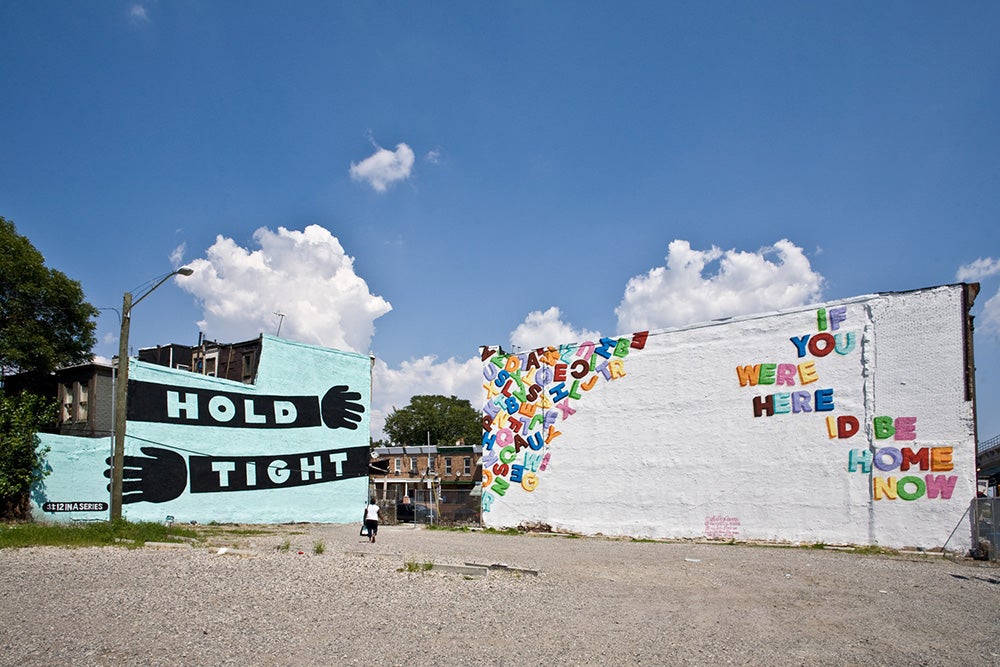
2. Cecil B. Moore Philadelphia Freedom Fighters
By Felix St. Fort & Gabe Tiberino | 2021 | 2201 College Avenue
In 1965 Cecil B. Moore, president of the city’s NAACP chapter, and a group of young activists organized protests to desegregate Girard College. The school was situated in a predominantly Black neighborhood. Their mission was eventually successful, giving those in the community a fair right to attend their local institution. Today, their devotion to civil rights and equality is paid to dedication in a mural on College Avenue and 22nd Street. In 2021, Felix St. Fort and Gabe Tiberino paid homage to their efforts by depicting Cecil B. Moore, and black and white images depicting the renowned protestors and activists of Philadelphia. In its background, you can see 10 adinkra symbols, modern-day Ghanaian visual symbols that represent different concepts. The Freedom Fighters chose ten to represent the values that they stand by: Knowledge, Unity, Perseverance, Power of Love, Fortitude, Service, Democracy, Justice, Excellence, and Encouragement.
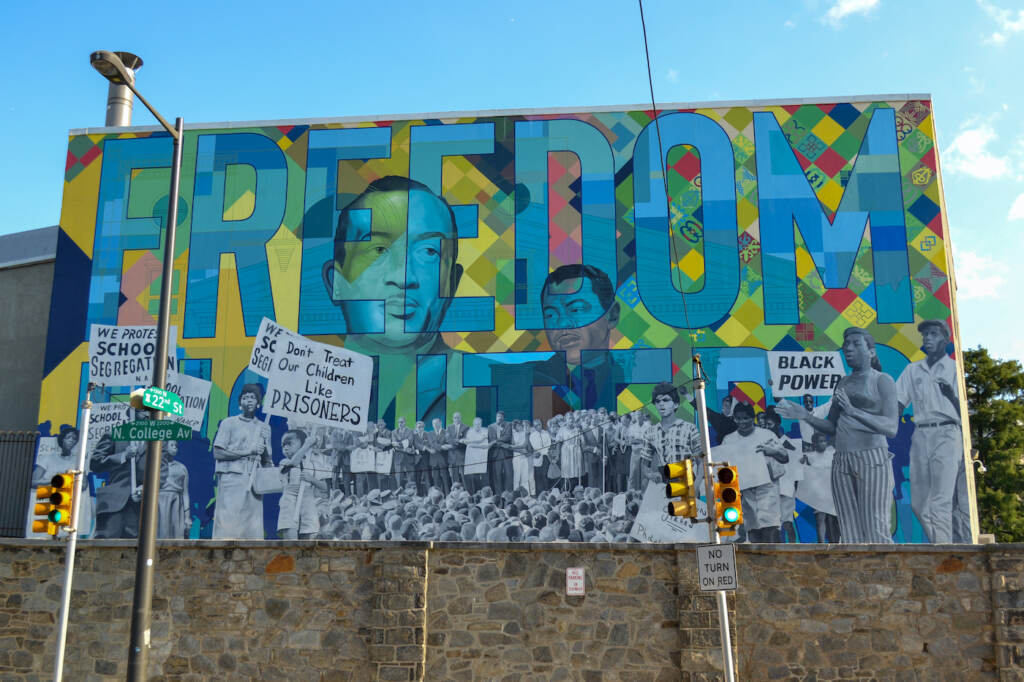
3. Common Threads
By Meg Saligman | 1999 | Broad and Spring Garden Streets
This timeless mural is one that can’t be missed as you hit the intersection of Broad and Spring Garden Street. Completed in 1999, the mural reveals a group of young adults, many of whom are posing as historical figures, and others simply looking into the distance with optimism. The wall was one that Saligman always wanted to paint when she began to do art in the city, and she used photographs of students who attended the Philadelphia High School for the Creative and Performing Arts as a reference.
In the center of the mural stands a young African American girl, a larger-than-life figure dressed in pink. And aside from her being the centerpiece, her aura radiates with poise and confidence. Today, she still leaves quite an impression on visitors and even Saligman:
“There was this one young lady who was walking down the hallway and she just had such a presence about her. And I said, “Would you like to pose?” And I was having the students take the same pose as the figurines. And she said, “Yeah, I’d like to pose, but I’d like to take my own pose.” And her name was Tamika, and she took her own clothes and she became the center of the mural, I’ve heard her refer to as the ‘Mona Lisa on Broad Street.’”
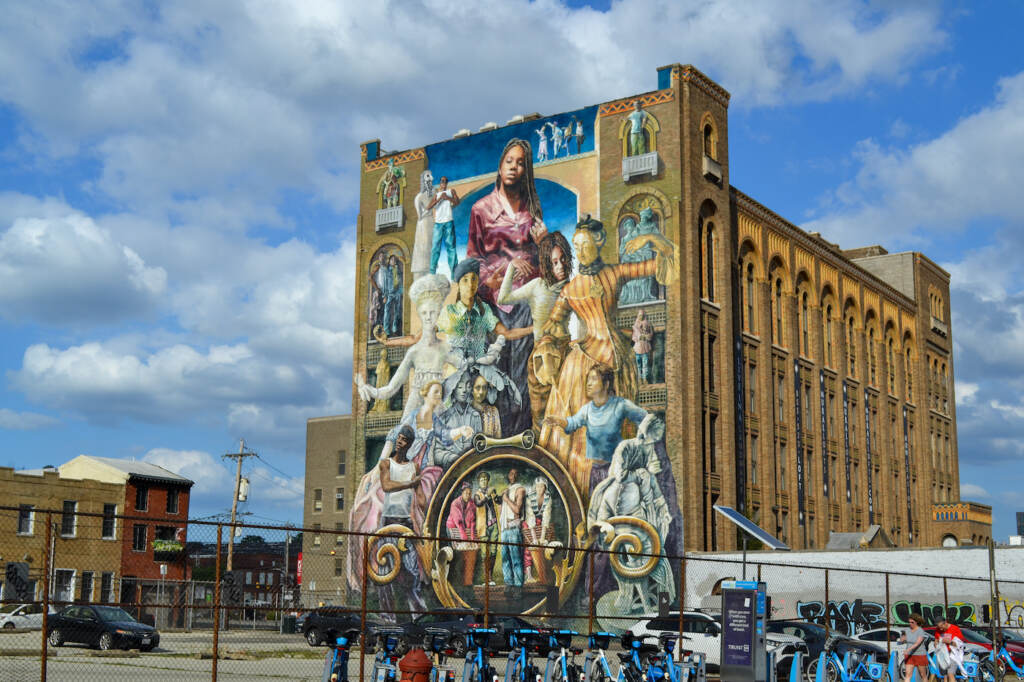
4. Dr. J
By Kent Twitchell | 1990 | 1234 Ridge Ave.
At the corner of Ridge Avenue and Green Street, there’s a man on a wall, and he’s three stories tall. That man is none other than Julius Erving, the 6’7″ athlete who played for the Philadelphia 76ers for 11 years in the late 1970s and 80s. The wall was painted in 1990 by Kent Twitchell, a California-based artist well known for his portraits and attention to detail. During this time, Mural Arts’ founder Jane Golden wanted a “breakthrough mural” that would speak to the evolution of the organization, and its contributions to the city, she told Mural Arts. Dr. J can be seen standing tall in a tan business suit, with brown shoes, eyeglasses, and a gold bracelet on his right wrist.
The essence of this mural continues to speak to his legacy, not only as a basketball player but as a mentor and role model. According to their site, Dr. J’s mural was so respected that it was used in another student-painted mural on the Spring Garden Street Bridge that depicted urban life.
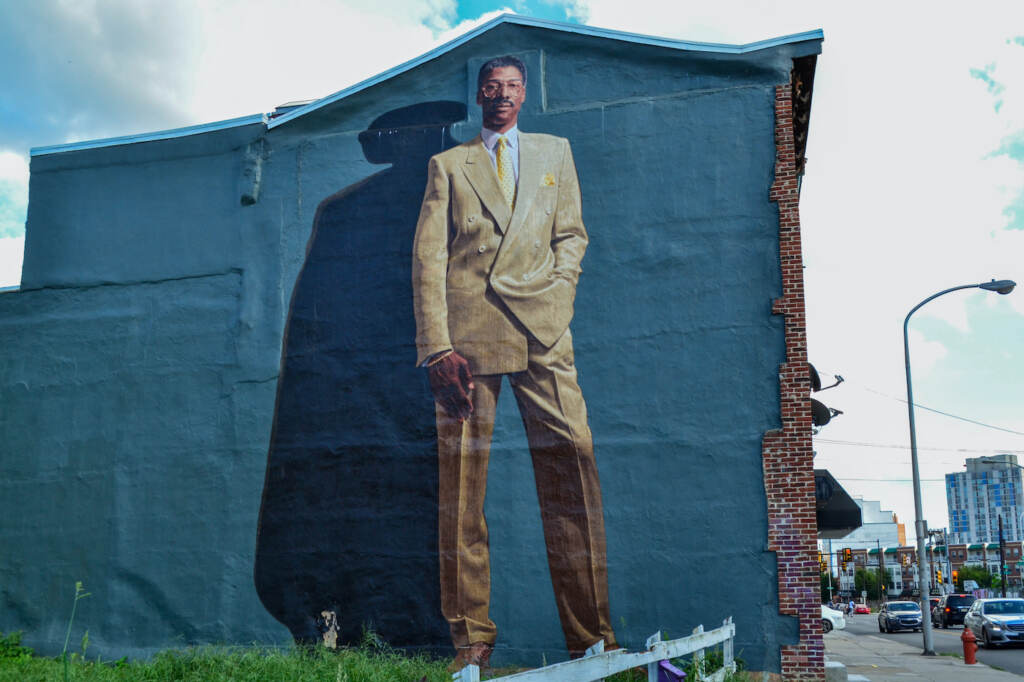
5. Healing Walls (Inmates Journey)/(Victims Journey)
By Cesar Viveros and Parris Stancell | 2004 | 3049 Germantown Ave. / 3065 Germantown Ave.
In 2002, Mural Arts Philadelphia partnered with the State Correctional Institute in Graterford, Pa. to teach art classes and work with both inmates and victims. “We worked with crime victims and victims advocates over a two-year period of time, and we would talk together about the impact of crime on communities and how we heal together,” said Golden. After a two-year period, and with the help of artists Cesar Viveros and Parris Stancell, the program brought life into two separate murals, depicting the battles that both victims and inmates face while attempting to transform the cycles of crime in their neighborhoods and in their own lives.
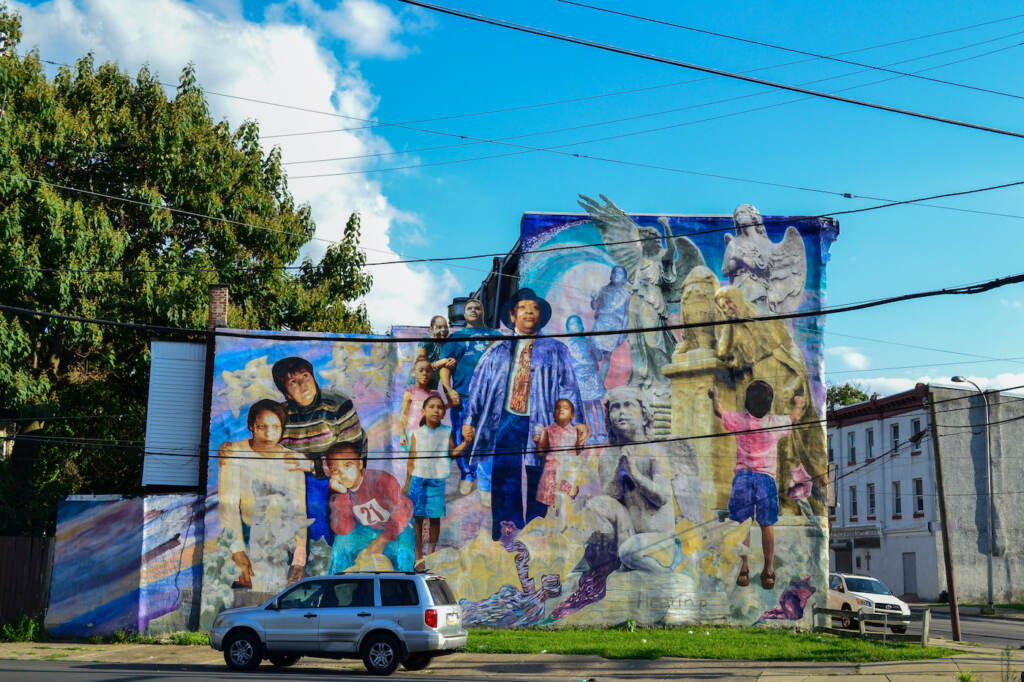
“All of it shines a light on our difference and distinction, which is wonderful but underscores a human our common humanity. And that is something that I think is unique to art,” said Golden.
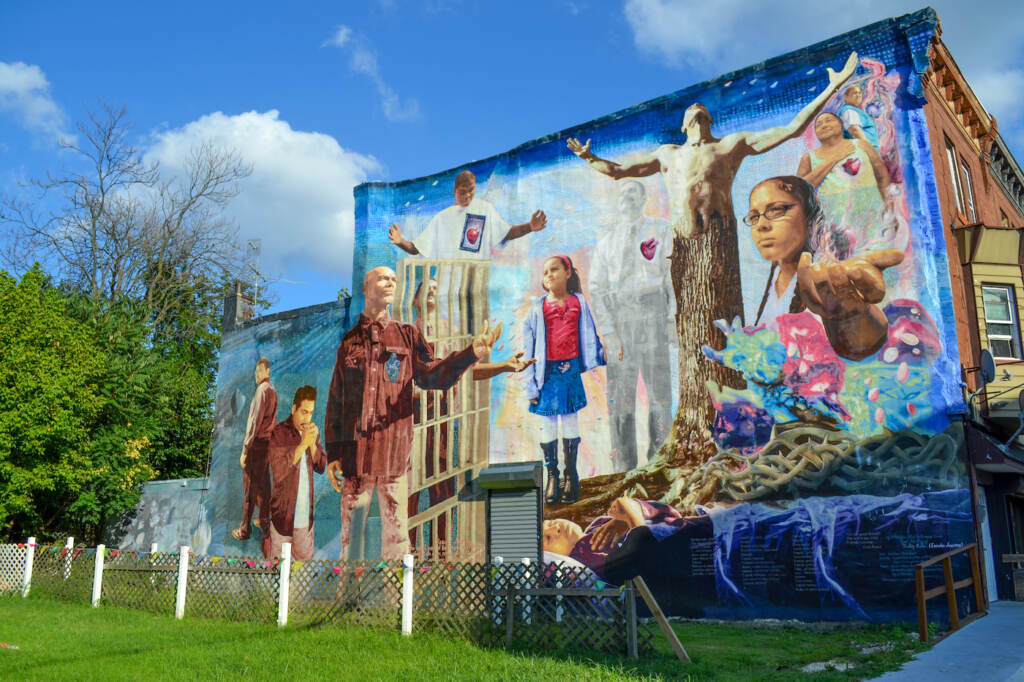
6. Jackie Robinson
By David McShane | 1997 | 2803 N. Broad Street
In 1972 the legend that broke the color barrier in major league baseball passed away, but on January 1, 1997, he and his legacy were immortalized right here in North Philadelphia. Illustrated by David McShane, the mural shows Jackie Robinson sliding into home base. This mural was one that inspired many, including those who lived close to it. Jane Golden recounted the feelings expressed by a woman who occupied the house.
“And then Ms. Porter would say to me, because we always stay in touch with people over the years who we work with. She’d say, Jane, every day I come out of my house and I see Jackie is a day I know my potential,” said Golden.
The painting which was requested by the Phillies, continues to speak volumes to and reflects upon the struggles and achievements of a man who fought on and off the field for people of color.
“The power of that mural, the power of potential, the way he fought racism, the way he sort of broke through. I mean, in spite of such just like so much hardship, so much racism coming his way, that sliding into home. It’s like this victory,” said Golden.
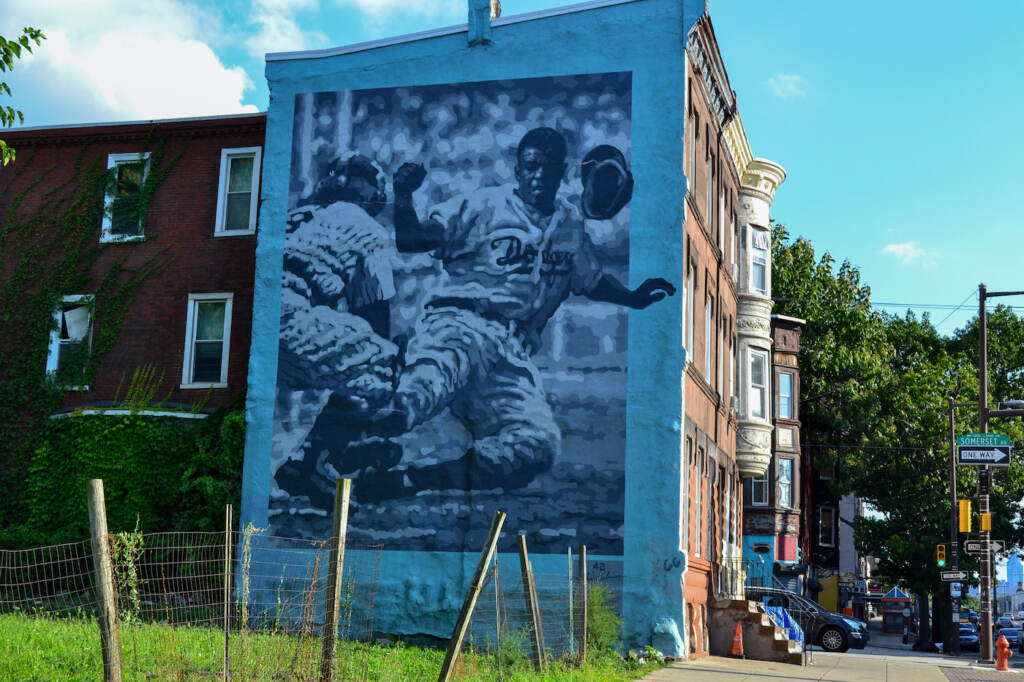
7. Our Flag Unfurled
By Meg Saligman | 2001 | Delaware Ave. and Spring Garden St. (visible from the Ben Franklin Bridge)
After the attack on 9/11, both our nation and city were left in disarray. Shortly after it happened, Meg Saligman decided to dedicate a mural to those who needed comfort in the wake of such a tragic event. The mural was painted on the south wall of the Philadelphia Warehousing and Cold Storage building and can be viewed from the I-95 highway. The flag, which is meant to convey both pride and pain, was a time-sensitive mural that was only supposed to be up for six weeks, however due to its impact on the community, it has remained the past 22 years and was even restored in 2016.
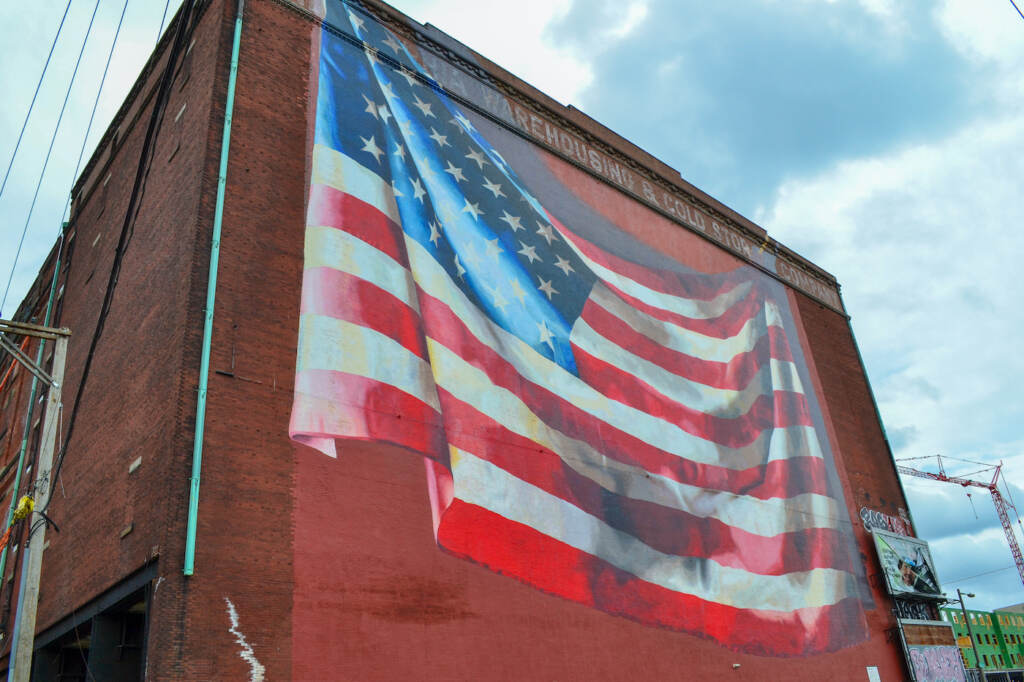
8. The Phillies Mural
By David McShane | 2015 | Adjacent to the Walnut Street Bridge (between 23rd and 24th on Walnut)
Nothing says Philly Pride more than our beloved sports teams, and in 2015 David McShane, the renowned sports muralist and Phillies enthusiast, paid homage to the Phillies, a team that has now been embedded in Philly culture for 140 years. This vibrant artwork captures the zealous energy of fans while symbolizing the team’s importance to Philadelphians. It binds together legendary players, stadiums, and historic moments, chronicling the franchise’s enduring legacy as the oldest one-name, one-city team in professional sports history.
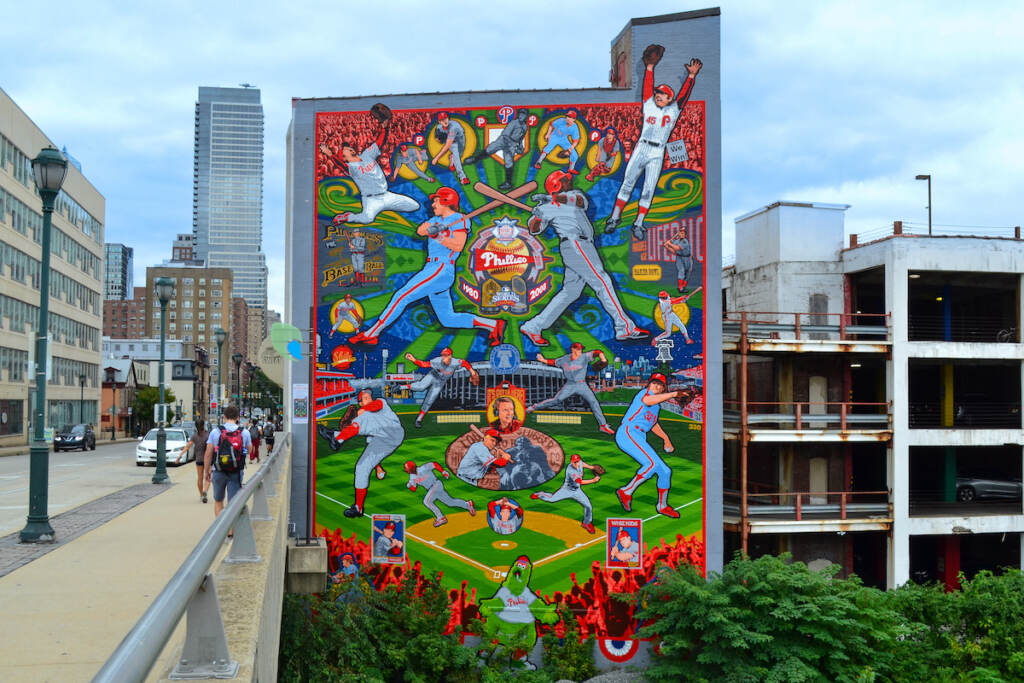
9. untitled
By Amy Sherald and Philly Mural Arts Program | 2019 | In the parking lot at the Target Store at 1108 Sansom St.
Amy Sherald, the Georgia native best known for her legendary portrait of Michelle Obama, took her talents to Philadelphia in 2019. She teamed up with Mural Arts and young local artists who were a part of the organization’s education program, and Sherald ended up using one of the young artists, Najee S., as her mural subject. Using her signature style of grey skin tones and bold bright colors, the mural challenges the social constructs of black identity. Her portrait now sits six stories high above a target in Center City.
This mural was more than just another artistic addition to the city for Jane Golden. “And it was inspiring in a big way because for me, having a young woman of color at 11th and Sansom eight stories tall, sort of speaks volumes about who we are as a city. Sometimes, if I’m near there, I just go by and stare at it because it’s so beautiful,” said Golden.
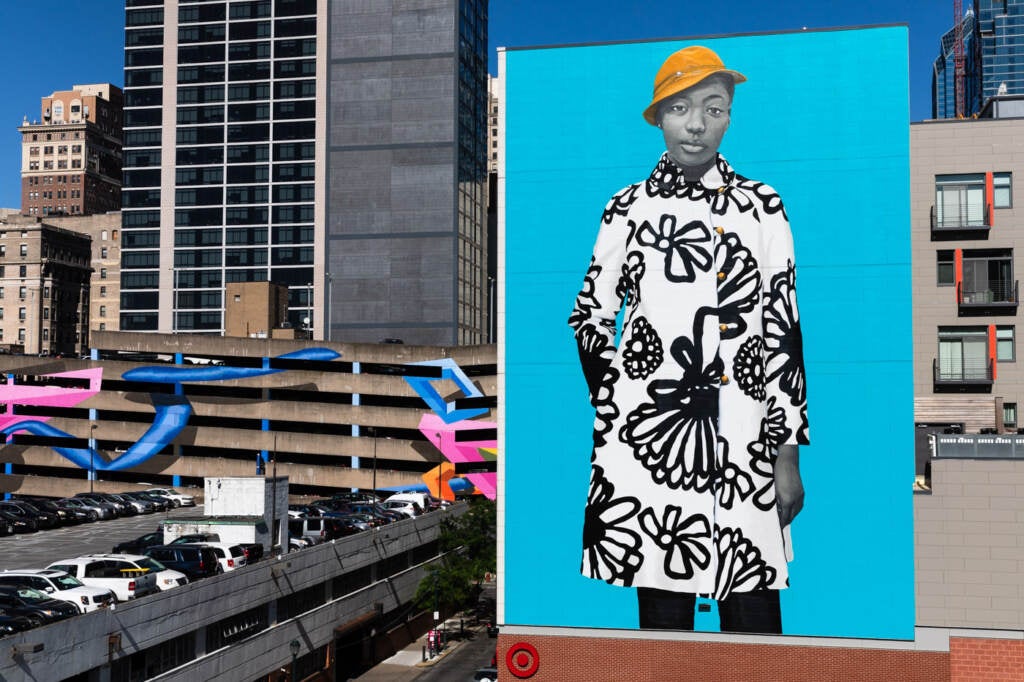
10. We The Youth
By Keith Haring | 1987 | 22nd and Ellsworth St.
During his lifetime, Keith Haring revolutionized art with his iconic and accessible style that bridged high art and pop culture. His commitment to social activism through art, addressing issues like AIDS and injustice, further cemented his legacy as a boundary-breaking artist. According to Mural Art’s site, We The Youth stands today as the “only Keith Haring collaborative public mural remaining intact and on its original site.” The mural, which is located on the west-facing wall of a rowhome in Point Breeze, Philadelphia, conveys Haring’s distinctive style marked by its iconic simplicity, vibrant colors, and dynamic figures in motion. The mural was completed in 1987 by Haring and later restored in 2013. It continues to highlight the importance of diversity and unity within our community.
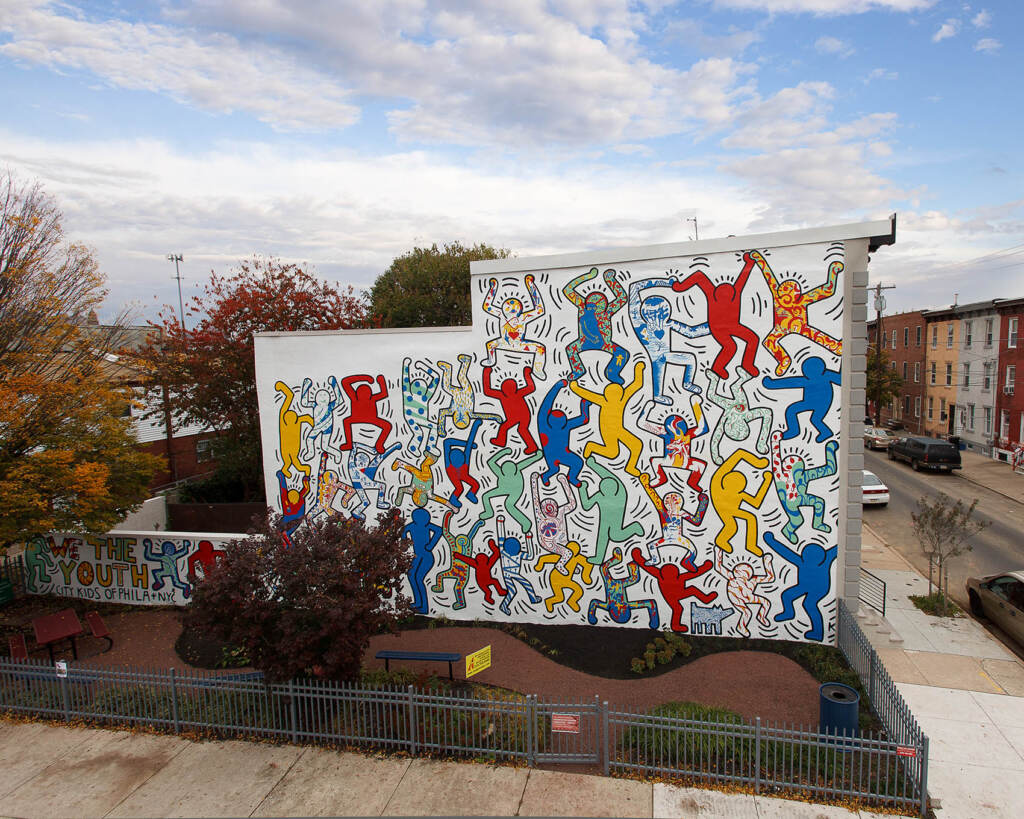
Top defaced murals:
1. Point of Triangulation: Intersection of Identity
By City of Philadelphia Mural Arts Program / Michelle Jones & Deborah Willis | 2021 | 21st Street and JFK Boulevard
In 2019, artists Michelle Jones and Deborah Willis teamed up with a cohort in Reimagining Reentry, a fellowship program designed to support formally incarcerated artists who want to speak on issues pertaining to mass incarceration. The 2-wall mural shows one group of people. On one side they are shown as inmates, stigmatized and shunned from society, while on the other side, they are free, dressed as they please, and truly shown with their own identity.
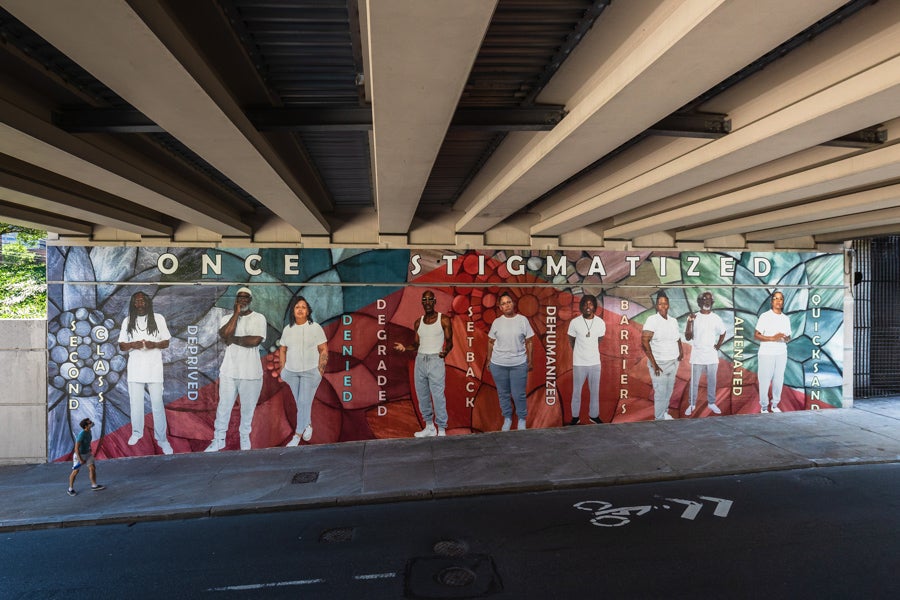
The mural used real citizens and acts as a visual form of activism against the prejudice and unconscious bias that we hold towards those who have been incarcerated.
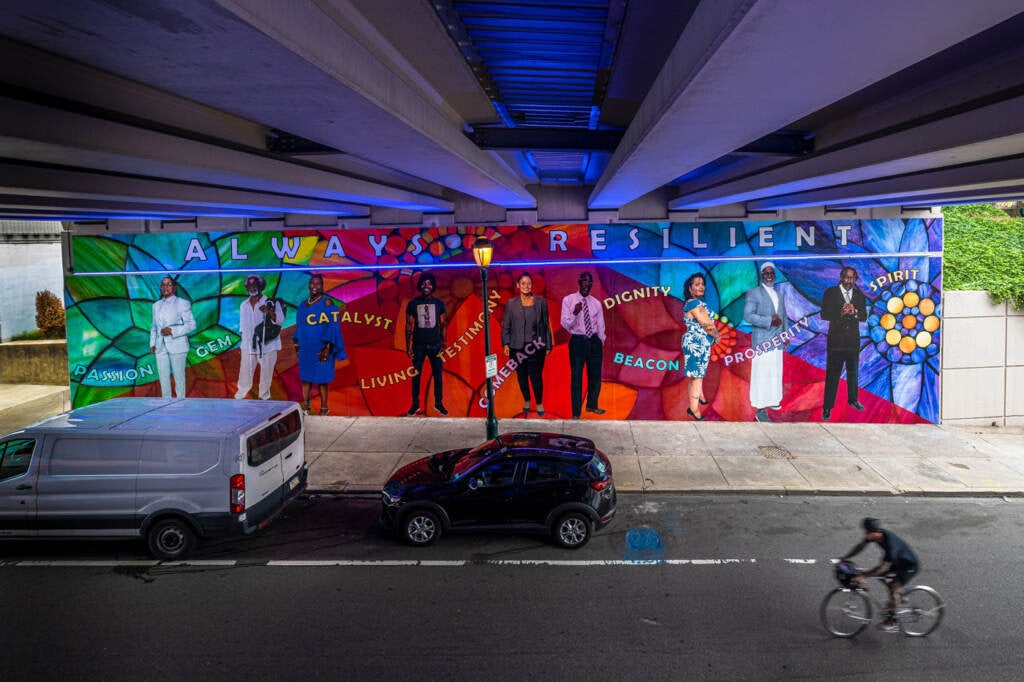
2. Flowering Axes
By Mat Tomezsko | 2018 | 5th Street vehicular and pedestrian tunnel
Mat Tomezsko’s Flowering Axes is a part of the 5th Street Tunnel murals, a collaboration project that was done with the help of Delaware River Port Authority, and two other artists, Brad Carney & Melissa Mandel. In addition to livening the experience for drivers, bikers, and pedestrians alike, these murals pay homage to bridge workers. Especially those who worked on the bridges that connect Philadelphia and New Jersey, and the Ben Franklin Bridge which sits right above the tunnels. Tomezsko’s mural sits above the vehicular tunnel, giving those driving by a visual filled with light and color.
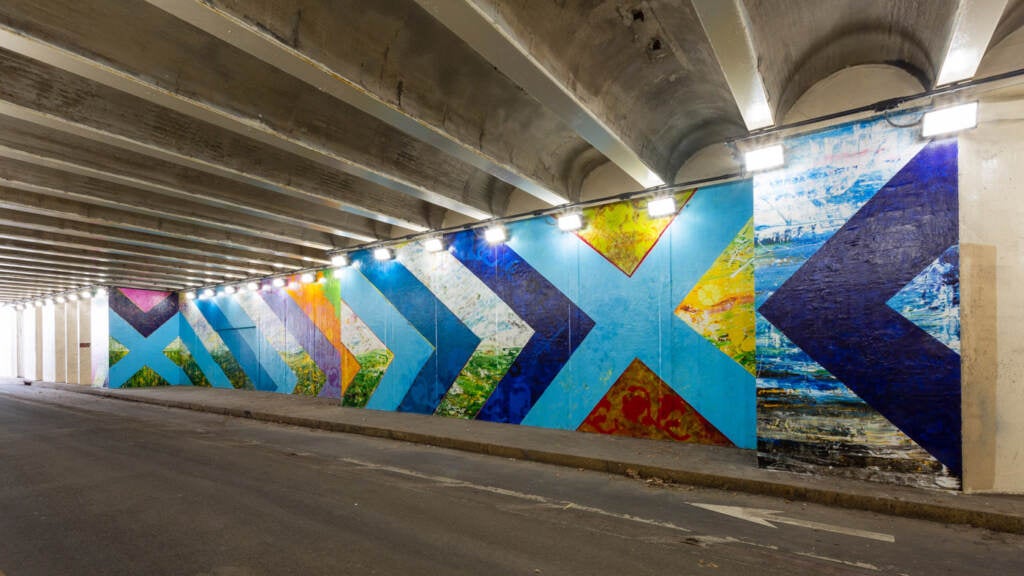
3. My Life, My Path, My Destiny
By Cesar Viveros | 2005 | 2157 E. Lehigh Ave. (intersection of Lehigh and Allegheny)
At the intersection of Tulip Street and Lehigh Avenue, there is a mural that all can relate to. In 2005, artist Cesar Vivernos created a piece that conveys the difficult journey that we all must go through as human beings, including the phases of innocence, pressure, choices, and fulfillment, all of which are listed above the mural. Using the help of local community members, students of St. Gabriel’s Hall, and The State Correctional Institution of Graterford, Pa., Vivernos aimed to connect the youth and inmates in order to help kids avoid mistakes that would later lead to crime. Those who participated assisted with the mural by filling in fabric panels, traced by the artist. “I purposefully had all the groups paint on some panels just to make a symbolic physical connection between them,” Vivernos told the Public Art Archive.
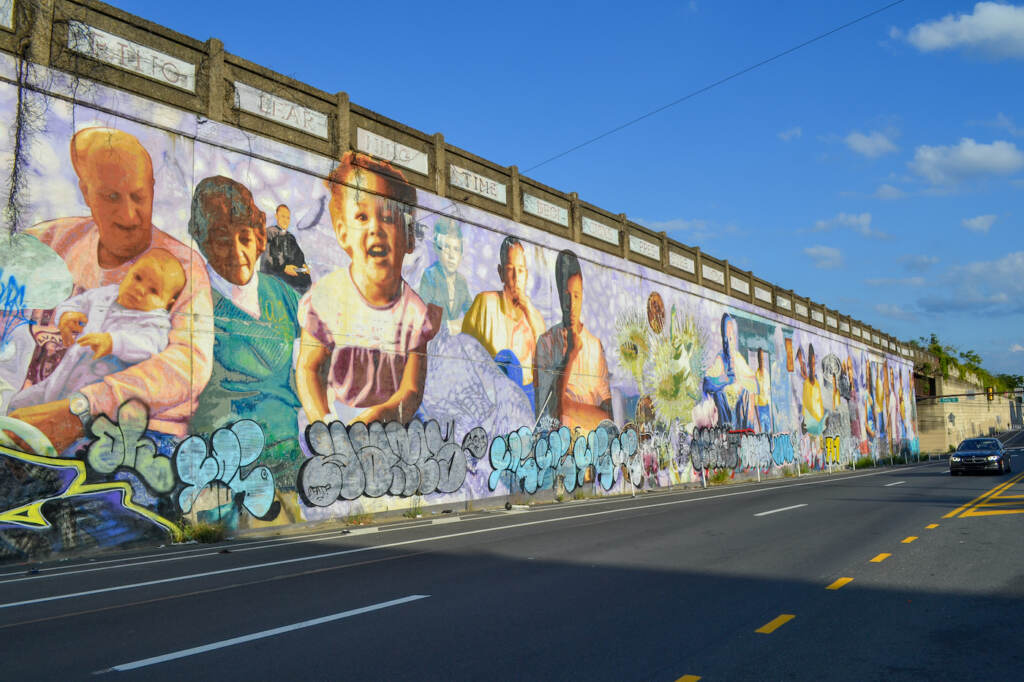
4. Healing Walls
By Cesar Viveros and Parris Stancell | 2004 | 3049 Germantown Ave. / 3065 Germantown Ave.
(See earlier entry)
5. Healing Begins Through Connection
By Caledonia Curry (aka SWOON) | 2018 | 2913 Kensington Ave.
In the spring of 2018, the artist SWOON launched a trauma-informed project in Philadelphia’s Kensington neighborhood. Collaborating with therapist Jessica Radovich and storyteller Heather Box, Swoon conducted workshops at the Kensington Storefront, focusing on self-care techniques through art. Weekly harm-reduction sessions helped connect participants to more advanced resources at the Prevention Point facility. Inspired by the workshops, Swoon designed the “Healing Begins Through Connection” mural, highlighting marginalized voices in the community. With a vibrant geometric backdrop by Swoon and lead muralist Doug Woods, the project also included a storytelling booklet and a behavioral health conference featuring Dr. Gabor Maté.
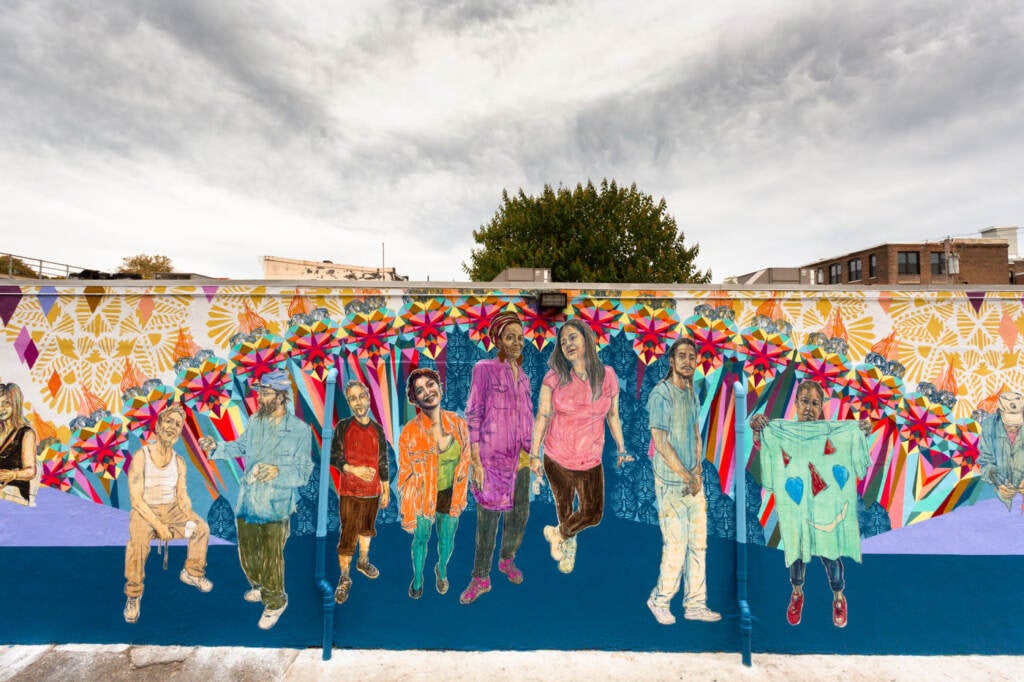
6. Passing Through (Ledge Wall)
By Meg Saligman | 2004 | I-76 at W. Girard Ave.
The Passing Through Philadelphia mural project, conceived by renowned muralist Meg Saligman, features a groundbreaking 5,000 sq. ft. interactive mural on the Schuylkill Expressway’s eastbound side at the Girard Avenue Bridge. This mural uses fine art, text, and trompe l’oeil techniques to point residents toward Center City, where they can begin their treasure hunt in search of the other 19 satellite murals that are spread out across the city. Each complimenting mural is designed to showcase local history through different images and sound recordings. The project’s aim is to offer viewers an immersive experience that takes them on a journey through the city’s neighborhoods, inviting them to engage with its culture and history in a captivating way.
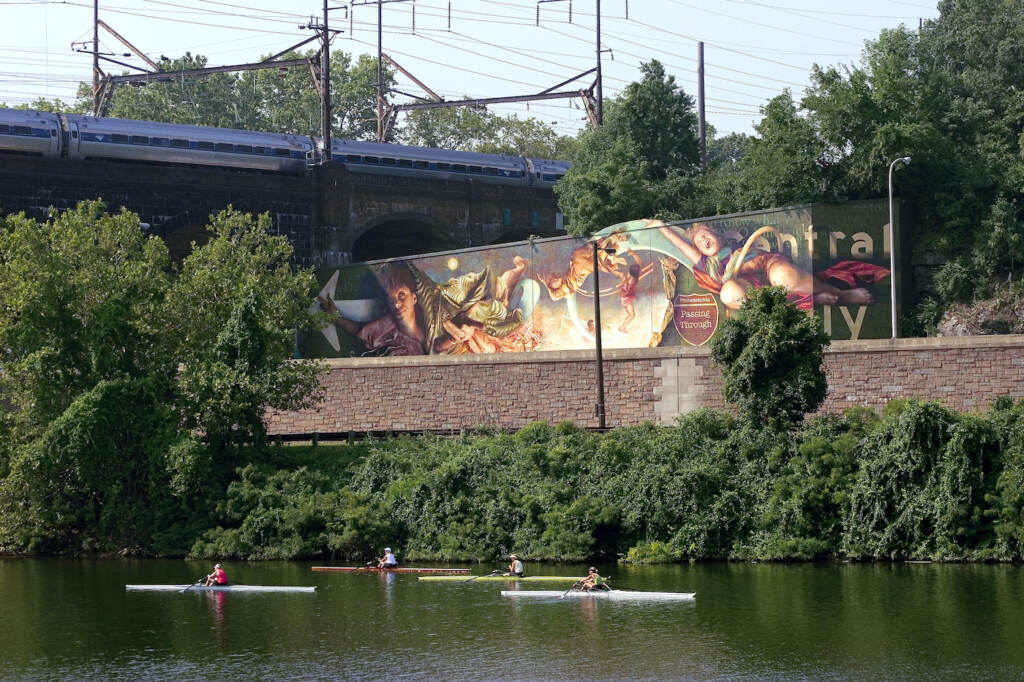
7. Philly Rowing (mural series)
By Jon Laidacker | 2014 | Kelly Drive at Girard Avenue Bridge, beneath the east and west banks
The Philly Rowing Mural, painted by Jon Laidacker pays tribute to Philadelphia’s extensive rowing history in the Schuylkill River. Showing its diversity as well as its significance in the community, a group of people can be seen rowing, and in its backdrop, a powerful view of the city can be seen. Pedestrians, bikers, and rowers alike can see the mural on their routes under the Girard Bridge.
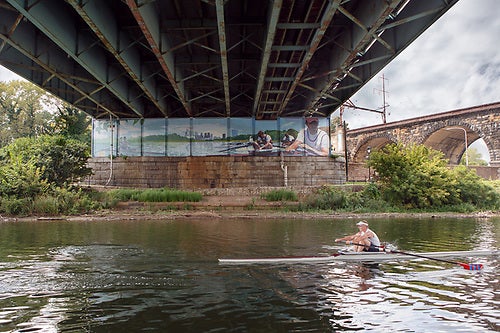
WHYY is your source for fact-based, in-depth journalism and information. As a nonprofit organization, we rely on financial support from readers like you. Please give today.


